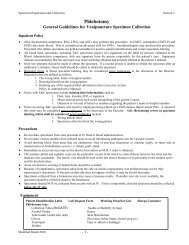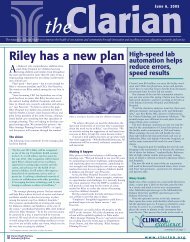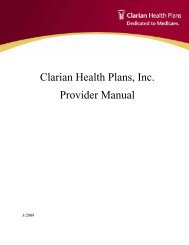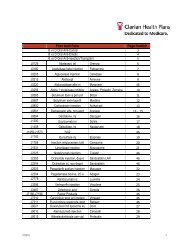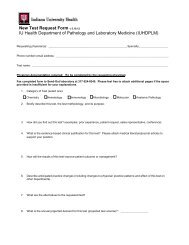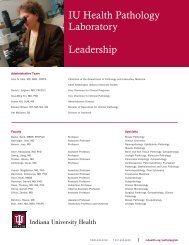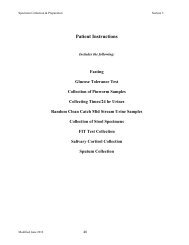Guidelines for Microbiology & Virology - IU Health
Guidelines for Microbiology & Virology - IU Health
Guidelines for Microbiology & Virology - IU Health
Create successful ePaper yourself
Turn your PDF publications into a flip-book with our unique Google optimized e-Paper software.
Specimen Preparation and Collection Section 3<br />
4. Prompt transport and handling of viral culture specimens is imperative <strong>for</strong> virus isolation.<br />
Storage Instructions: Transport to the laboratory immediately. Do not freeze. Leave blood at room temp; refrigerate all<br />
other specimens.<br />
Causes <strong>for</strong> rejection: Improper specimen type, delayed transport to the laboratory, specimen fixed in <strong>for</strong>malin. If an<br />
unacceptable specimen is received, the appropriate physician or nursing station will be notified<br />
and another specimen will be requested be<strong>for</strong>e disposal of the original specimen.<br />
Specimens received in the laboratory by 1 pm on Monday - Friday and by 8:00 am on Saturday will<br />
be processed the same day.<br />
General <strong>Guidelines</strong> <strong>for</strong><br />
Antimicrobial Susceptibility Testing<br />
General<br />
1. Antimicrobial susceptibility testing is per<strong>for</strong>med on all potential pathogens recovered in any amount from normally<br />
sterile body sites or present in significant numbers from sites, which have indigenous flora.<br />
2. Representative isolates from all positive cultured specimens are saved <strong>for</strong> one week.<br />
3. All blood and spinal fluid isolates are saved indefinitely.<br />
4. Tests are per<strong>for</strong>med daily, and results usually available 24 - 48 hours after isolation of microorganisms.<br />
Minimum Inhibitory Concentration (MIC)<br />
1. The MIC is the lowest concentration of an antimicrobial, which inhibits growth of the microorganism tested.<br />
2. It is achieved using an automated (Vitek), manual broth micro dilution test systems, or E-Test Strips. .<br />
3. The test method is effective <strong>for</strong> rapidly growing, aerobic, non-fastidious bacteria.<br />
4. Selection of antimicrobials on each test panel is determined based on organism’s type (gram positive or gram<br />
negative), body site, (urine or nonprime), and spectrum of activity.<br />
5. MIC values (susceptible, intermediate, resistant) are reported in terms of achievable levels of antimicrobial agent<br />
in serum and urine.<br />
Agar Disk Diffusion (Kirby-Bauer)<br />
1. The Agar Disk Diffusion test uses a single-potency disk <strong>for</strong> semi quantitative interpretation (susceptible,<br />
intermediate, resistant).<br />
2. It is occasionally used <strong>for</strong> fastidious organisms or newly introduced antibiotics.<br />
Agar Screen Test<br />
1. The Agar Screen Test uses a single breakpoint concentration of antimicrobial <strong>for</strong> qualitative interpretation<br />
(susceptible and resistant).<br />
2. It is used <strong>for</strong> Staph aureus (Oxacillin-Methacillin), and Enterococci (Vancomycin).<br />
E-Test<br />
1. The E-Test uses a strip coated with a logarithmic gradient of an antimicrobial agent applied to an inoculated plate.<br />
2. After incubation, an ellipse of inhibition is <strong>for</strong>med.<br />
3. At the intersection of the ellipse with the strip, the MIC is read from the interpretative scale.<br />
4. It is used <strong>for</strong> Streptococcus Pneumoniae and other fastidious organisms.<br />
Beta Lactamase Test<br />
1. Beta-lactamases are degradative enzymes capable of hydrolyzing beta-lactam antimicrobials (penicillins,<br />
cephalosporins).<br />
2. Routine testing <strong>for</strong> beta-lactamase production is per<strong>for</strong>med on all Bactericides spp., Haemophilus spp., Moraxella<br />
catarrhalis, and Neisseria gonorrhoeae when susceptibility testing is indicated.<br />
Selective Testing<br />
1. Anaerobes<br />
a. A reference lab on request, per<strong>for</strong>ms susceptibility testing of anaerobes only.<br />
b. The beta-, test is routinely used on Bactericides spp and other anaerobic gram-positive rods.<br />
Modified March 2010 - 16 -




